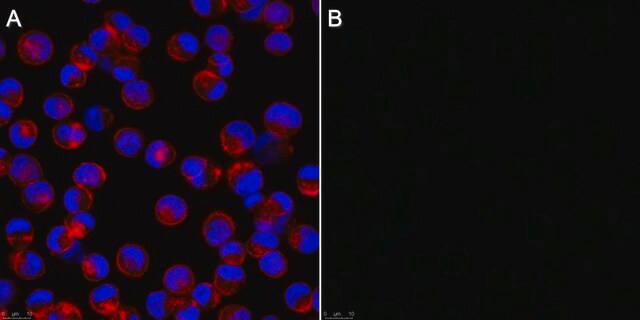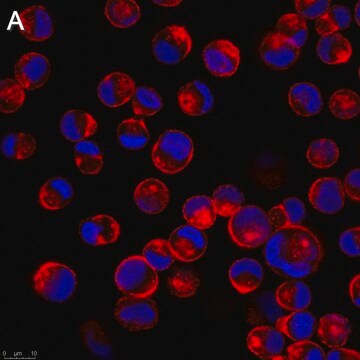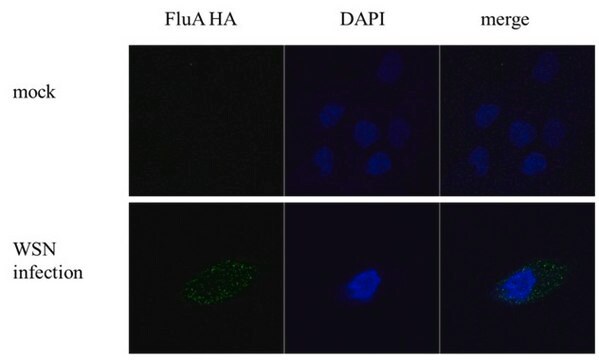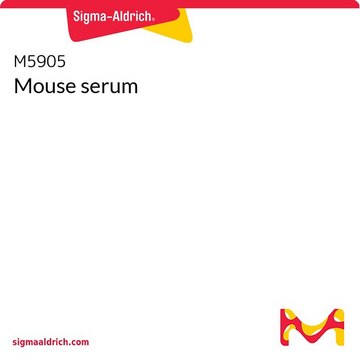MAB8661
Anti-Influenza B Antibody, nucleoprotein, clones B2, B4 Blend
ascites fluid, Chemicon®, from mouse
Zaloguj sięWyświetlanie cen organizacyjnych i kontraktowych
About This Item
Kod UNSPSC:
12352203
eCl@ss:
32160702
NACRES:
NA.41
Polecane produkty
pochodzenie biologiczne
mouse
Poziom jakości
forma przeciwciała
ascites fluid
rodzaj przeciwciała
primary antibodies
klon
B2, monoclonal
B4, monoclonal
reaktywność gatunkowa
human
producent / nazwa handlowa
Chemicon®
metody
immunofluorescence: suitable
izotyp
IgG
Warunki transportu
wet ice
Specyficzność
Recognizes all subtypes of Influenza B. Blend of two clones that recognize the nucleoprotein antigen.
No cross-reactivity to influenza A, parainfluenza 1, 2 or 3, adenovirus or RSV.
No cross-reactivity to influenza A, parainfluenza 1, 2 or 3, adenovirus or RSV.
Immunogen
Influenza Blend.
Zastosowanie
Anti-Influenza B Antibody, nucleoprotein, clones B2, B4 Blend detects level of Influenza B & has been published & validated for use in IF.
Indirect immunofluorescence at 1:100.
Final working dilutions must be determined by end user.
Final working dilutions must be determined by end user.
Research Category
Infectious Diseases
Infectious Diseases
Research Sub Category
Infectious Diseases - Viral
Infectious Diseases - Viral
Postać fizyczna
Ascites fluid with 0.1% sodium azide as a preservative.
Unpurified
Przechowywanie i stabilność
Maintain for 1 year at -20°C from date of shipment. Aliquot to avoid repeated freezing and thawing. For maximum recovery of product, centrifuge the original vial after thawing and prior to removing the cap.
Komentarz do analizy
Control
Influenza Control Slides, Catalogue Number 5010-5
Influenza Control Slides, Catalogue Number 5010-5
Inne uwagi
Concentration: Please refer to the Certificate of Analysis for the lot-specific concentration.
Informacje prawne
CHEMICON is a registered trademark of Merck KGaA, Darmstadt, Germany
Oświadczenie o zrzeczeniu się odpowiedzialności
Unless otherwise stated in our catalog or other company documentation accompanying the product(s), our products are intended for research use only and are not to be used for any other purpose, which includes but is not limited to, unauthorized commercial uses, in vitro diagnostic uses, ex vivo or in vivo therapeutic uses or any type of consumption or application to humans or animals.
Ta strona może zawierać tekst przetłumaczony maszynowo.
Nie możesz znaleźć właściwego produktu?
Wypróbuj nasz Narzędzie selektora produktów.
Kod klasy składowania
12 - Non Combustible Liquids
Klasa zagrożenia wodnego (WGK)
nwg
Temperatura zapłonu (°F)
Not applicable
Temperatura zapłonu (°C)
Not applicable
Certyfikaty analizy (CoA)
Poszukaj Certyfikaty analizy (CoA), wpisując numer partii/serii produktów. Numery serii i partii można znaleźć na etykiecie produktu po słowach „seria” lub „partia”.
Masz już ten produkt?
Dokumenty związane z niedawno zakupionymi produktami zostały zamieszczone w Bibliotece dokumentów.
Genetic variability of human metapneumovirus isolated from Chilean children, 2003-2004.
Carola Escobar,Vivian Luchsinger,Danielle Bruna de Oliveira,Edison Durigon et al.
Journal of Medical Virology null
Kevin R McCarthy et al.
Proceedings of the National Academy of Sciences of the United States of America, 118(23) (2021-06-03)
Immune memory of a first infection with influenza virus establishes a lasting imprint. Recall of that memory dominates the response to later infections or vaccinations by antigenically drifted strains. Early childhood immunization before infection may leave an imprint with different
Aaron G Schmidt et al.
Cell, 161(5), 1026-1034 (2015-05-12)
Vaccines for rapidly evolving pathogens will confer lasting immunity if they elicit antibodies recognizing conserved epitopes, such as a receptor-binding site (RBS). From characteristics of an influenza-virus RBS-directed antibody, we devised a signature motif to search for similar antibodies. We
Paulina Koszalka et al.
Antiviral research, 164, 91-96 (2019-02-17)
Baloxavir Marboxil (BXM) is an influenza polymerase inhibitor antiviral that binds to the endonuclease region in the PA subunit of influenza A and B viruses. To establish the baseline susceptibility of viruses circulating prior to licensure of BXM and to
Tina Schmidt et al.
European journal of immunology, 42(7), 1755-1766 (2012-05-16)
Antigen-specific antibodies are well characterized after vaccination with pandemic H1N1 or seasonal influenza vaccines. However, knowledge on cellular immunity toward pandemic H1N1 after vaccination and infection and cross-reactivities toward seasonal antigens is limited. Nineteen individuals were vaccinated with the pandemic
Nasz zespół naukowców ma doświadczenie we wszystkich obszarach badań, w tym w naukach przyrodniczych, materiałoznawstwie, syntezie chemicznej, chromatografii, analityce i wielu innych dziedzinach.
Skontaktuj się z zespołem ds. pomocy technicznej





